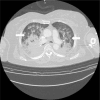Negative pressure pulmonary edema after nasal fracture reduction in an obese female patient: a case report
- PMID: 26316826
- PMCID: PMC4547658
- DOI: 10.2147/IMCRJ.S86099
Negative pressure pulmonary edema after nasal fracture reduction in an obese female patient: a case report
Abstract
Postoperative negative pressure pulmonary edema (NPPE) is a rare, but well-known life-threatening complication of acute upper airway obstruction (UAO) which develops after general anesthesia. The pronounced inspiratory efforts following UAO lead to excessive negative inspiratory pressure, which may cause acute pulmonary edema. Early recognition and prompt treatment of NPPE is necessary to prevent patient morbidity and mortality. In addition, the physician should carefully manage the patient who has risk factors of UAO to prevent this situation. We experienced a case of NPPE following laryngospasm after tracheal extubation in an obese patient who underwent open reduction of orbital wall and nasal bone surgery.
Keywords: airway obstruction; laryngospasm; nasal surgery; negative pressure pulmonary edema; obese.
Figures



Similar articles
-
Negative-pressure pulmonary edema following maxillofacial surgery: recognize to prevent further complications.Oral Maxillofac Surg. 2024 Mar;28(1):447-449. doi: 10.1007/s10006-022-01122-6. Epub 2022 Oct 14. Oral Maxillofac Surg. 2024. PMID: 36239828
-
[Negative pressure pulmonary edema following a cholecystectomy - A case report].Rev Pneumol Clin. 2017 Oct;73(5):267-271. doi: 10.1016/j.pneumo.2017.08.006. Epub 2017 Oct 18. Rev Pneumol Clin. 2017. PMID: 29054715 French.
-
Negative pressure pulmonary edema (Review).Exp Ther Med. 2023 Aug 4;26(3):455. doi: 10.3892/etm.2023.12154. eCollection 2023 Sep. Exp Ther Med. 2023. PMID: 37614417 Free PMC article. Review.
-
Negative pressure pulmonary edema after oral and maxillofacial surgery.Anesth Prog. 2009 Summer;56(2):49-52. doi: 10.2344/0003-3006-56.2.49. Anesth Prog. 2009. PMID: 19642719 Free PMC article.
-
[Negative-pressure pulmonary edema (NPPE)].Anasthesiol Intensivmed Notfallmed Schmerzther. 2006 Feb;41(2):64-78. doi: 10.1055/s-2006-924969. Anasthesiol Intensivmed Notfallmed Schmerzther. 2006. PMID: 16493558 Review. German.
Cited by
-
Negative pressure pulmonary edema after general anesthesia: A case report and literature review.Medicine (Baltimore). 2019 Apr;98(17):e15389. doi: 10.1097/MD.0000000000015389. Medicine (Baltimore). 2019. PMID: 31027133 Free PMC article. Review.
-
Pediatric Cervicofacial Necrotizing Fasciitis-A Challenge for a Medical Team.Children (Basel). 2023 Jul 22;10(7):1262. doi: 10.3390/children10071262. Children (Basel). 2023. PMID: 37508759 Free PMC article.
-
Negative-pressure pulmonary edema after mammoplasty: a case report.Pan Afr Med J. 2022 May 9;42:15. doi: 10.11604/pamj.2022.42.15.32010. eCollection 2022. Pan Afr Med J. 2022. PMID: 35812256 Free PMC article.
-
A Complex Presentation of Acute Postoperative Negative-Pressure Pulmonary Edema: A Case Report and Review of Literature.Cureus. 2023 Jul 19;15(7):e42152. doi: 10.7759/cureus.42152. eCollection 2023 Jul. Cureus. 2023. PMID: 37602134 Free PMC article.
-
Negative-pressure-related diffuse alveolar hemorrhage after monitored anesthesia care for vertebroplasty: a case report.J Med Case Rep. 2021 Mar 16;15(1):137. doi: 10.1186/s13256-021-02697-6. J Med Case Rep. 2021. PMID: 33722271 Free PMC article.
References
-
- Patton WC, Baker CL., Jr Prevalence of negative-pressure pulmonary edema at an orthopaedic hospital. J South Orthop Assoc. 2000;9(4):248–253. - PubMed
-
- Tami TA, Chu F, Wildes TO, Kaplan M. Pulmonary edema and acute upper airway obstruction. Laryngoscope. 1986;96(5):506–509. - PubMed
-
- Louis PJ, Fernandes R. Negative pressure pulmonary edema. Oral Surg Oral Med Oral Pathol Oral Radiol Endod. 2002;93(1):4–6. - PubMed
-
- Krodel DJ, Bittner EA, Abdulnour R, Brown R, Eikermann M. Case scenario: acute postoperative negative pressure pulmonary edema. Anesthesiology. 2010;113(1):200–207. - PubMed
Publication types
LinkOut - more resources
Full Text Sources

